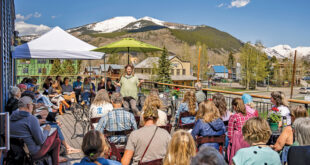But is anyone listening?
“I’m a local rancher’s wife, and a rancher myself,” said Phyllis Guerrieri, at the November 19 public hearing for the proposed addition of the Gunnison sage grouse to the Endangered Species List.
“I’ve lived here all my life,” said Guerrieri, “and I’ve watched the sage chicken my entire life. I just wonder what the federal government can do to protect the grouse—I call it a chicken—that we have not been able to do with all our efforts. What can they do other than what we have already done?”
It was a simple question. Yet it sat heavy and loaded before the panel of United States Fish and Wildlife Service (USFWS) representatives who had been assigned the task of witnessing the comments and questions from stakeholders within Gunnison County.
Finally USFWS Colorado field supervisor Susan Linner answered that listing the grouse would create a federal management plan that would serve as a guideline for all federal agencies. As might be expected, that response fell a little flat.
Since 1995 local, regional and state stakeholder groups have been working to conserve and protect the Gunnison sage grouse and its habitat in southwestern Colorado. As part of this effort more than $30 million has been spent on conservation and land easements in the region.
However, last January the federal government proposed listing the Gunnison sage grouse and its associated critical habitat to the Endangered Species List.
In recommending the Gunnison sage grouse be listed as endangered, USFWS all but dared Gunnison County and several regional and statewide working groups to prove that their locally based conservation efforts had been, and would continue to be, an effective tool in protecting and conserving the grouse. The bird is native to the sage brush habitat of southwest Colorado.
Over the past year the groups have risen to the challenge, but despite their best arguments, which in many cases have been backed up by hard data and qualitative results showcasing the many conservation efforts, it seems the Gunnison sage grouse may still be headed for listing and ultimately federal regulation. That in turn has left many people like Guerrieri asking why.
According to Patty Gelatt, Western Colorado supervisor for the USFWS, the only determinations used when the federal government determines whether or not to list a species under the ESA are biological.
“There are seven populations [of Gunnison sage grouse] occupying almost one million acres,” said Gelatt. “Combined, there are almost 4,600 birds, with the largest population in the Gunnison basin.”
While the Gunnison population has been stable for the last several years, general population trends over the last 12 years show six of the populations are in decline, said Gelatt, adding that habitat loss and fragmentation are real threats to the grouse in all locations and may be a primary concern in their potential listing.
“Listing comes down to the overall status of the species,” said Gelatt. “We recognize the efforts that have been done here, but the listing requires looking at the overall status” and, according to the science being used in consideration of listing, that overall status is not good.
Lisa Dale from Colorado’s Department of Natural Resources, speaking on behalf of Colorado Governor John Hickenlooper, said that conclusion was inaccurate and faulty.
“The state believes, and the science supports, that the species is secure for the foreseeable future,” said Dale. “A listing at this time would be a powerful statement against proactive conservation, and would do little to conserve the species.”
Katy Griffin, Colorado Parks and Wildlife’s statewide conservation coordinator for grouse, agreed that the USFWS was drawing the wrong conclusions.
“There are significant concerns with the science being used for the listing proposal,” she said. “We believe the best available science demonstrates the species is secure across much of its range. The key to its survival is habitat, and more than 68,000 acres are currently managed for the protection and conservation of the grouse.”
Gunnison County Commissioner Jonathan Houck echoed Griffin’s sentiment.
“Since 1995 we’ve been working to conserve and protect grouse. We’ve achieved that goal,” he said. “The proposed rule missed the mark. We ask that you hold us accountable and demand that we keep our end of the bargain, but support us in our efforts [of regional management].”
The USFWS will continue to take public comment of the proposed listing of the Gunnison sage grouse through December 2.
For more information on how to submit a comment, visit http://www.fws.gov/mountain-prairie/species/birds/gunnisonsagegrouse/.
 The Crested Butte News Serving the Gunnison Valley since 1999
The Crested Butte News Serving the Gunnison Valley since 1999



